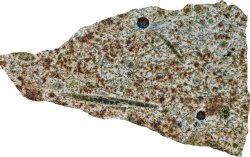
Photo by Steve Jurvetson
licensed under the Creative Commons Attribution 2.0 Generic license
 Photo by Steve Jurvetson licensed under the Creative Commons Attribution 2.0 Generic license | This meteorite from the Sahara desert originated from a protoplanet. It is incredibly ancient. |
Thousands of meteorites have landed on Earth at different times, but the meteorite found in the Sahara desert in May 2020 is not like any other rocky meteorites. It has the designated number EC 002, with EC standing for the Erg Chech - a vast sandy region of the Sahara Desert near Adrar in Algeria. Erg is a broad, flat area of desert covered with wind-swept sand dunes where almost nothing grows. EC 002 was one of several chunks of meteorite discovered in this region. The total weight of all these fragments came to 32 kilograms.
According to the Meteoritical Bulletin database (ref 1) EC 002 is a relatively coarse grained, tan and beige meteorite which has sporadic larger green, yellow-green and (less commonly) yellow-brown crystals with the largest crystals being 9x4 cm in size. After examination, EC 002 was classified as achondrite.
Achondrites are defined as differentiated meteorites which lack chondrules - (small circular bodies containing mostly silicate minerals olivine and pyroxene). They are relatively uncommon. They consist of material similar to terrestrial basalts or plutonic rocks (igneous rocks which form by the slow solidification of magma deep below the surface and characterized by large crystals - granite being an example.) The rock in achondrites has thus been differentiated and reprocessed to a lesser or greater degree due to melting and recrystallization either within the meteorite or its parent body.
The majority of known meteorites are chondrites which originate from the asteroid belt. Only about 8% of stony meteorites which land on Earth are achondrites (a name which basically means 'not chondrites'). A few of these achondrites originated from our Moon or Mars, but most achondrites found on Earth (approximately 75 percent) are thought to have originated from a single asteroid called 4 Vesta. 4 Vesta is the second most massive body in the main asteroid belt, accounting for almost 9% of the total mass of all the asteroids in the belt. Unlike most known asteroids, 4 Vesta has separated into crust, mantle and core (characteristics of more differentiated bodies) and is mostly spherical. Some believe that 4 Vesta should be really classified as a dwarf planet putting it in the same category as the demoted former planet Pluto.
Achondrites are more likely to originate from planetary bodies where they have already undergone igneous processes.The ratio of iron to manganese (Fe/Mn) as well as the oxygen isotope ratios (17O/18O) serves as a 'fingerprint' for each parent body. For example, the Moon is known to be depleted in volatile elements such as sodium (Na) or manganese (Mn) so lunar meteorites will have much higher Fe/Mn ratios than many other meteorites and planetary basalts. So we know that EC 002 did not come from the moon or Mars.
As mentioned above, most achondritic meteorites originate from basaltic sources. EC 002 is exceptional as its composition is mostly andesite which is typically found in lava flows. On Earth andesite is produced by stratovolcanoes above subduction zones. Because lava cools rapidly on the surface andesites are generally composed of small crystals. So andesite is a family of fine-grained, extrusive igneous rocks which are light to dark gray. Andesites have mineral compositions which are intermediate between granite and basalt. Therefore the presence of andesite shows that EC 002 came from a planetary body - and a body that was not 4 Vesta.
The exciting thing about EC 002 is that in addition to being an andesite, EC002 is very, very old. More precisely, dating using a technique based on radioactive aluminium-26 (26Al-26Mg) shows that EC 002 is roughly 4.566 billion years old. This makes it older than any piece of igneous crust ever discovered on Earth, mainly because EC 002 is actually older than the Earth. It follows that wherever EC 002 comes from was also older than the Earth and dates from the earliest years of the solar system.
(Aluminium-26 is a radioactive isotope which decays into a stable magnesium-26 with a half life of 730 thousand years. Magnesium naturally occurs in three stable isotopes, 24Mg, 25Mg, and 26Mg. By measuring the excess of 26Mg relative to other isotopes in the meteorite it is possible to estimate the age of this meteorite. The authors of the recently published study in the PNAS (ref 2) argue that the age of the EC002 implies that the formation of protoplanets began during the first millions of years of the life of our solar system. Assuming that 26Al was distributed evenly in the solar system, the heat generated by its decay allowed for early protoplanets to differentiate into more complex bodies containing igneous crust and segregation at depth of a metallic core.)
The authors believe that protoplanets covered by andesitic crusts were probably common billions of years ago and EC 002 originates from one of these. However, since the chemical features of EC002 are unique (i.e. no asteroid shares similar chemical spectra), the researchers suggest that almost all remnants of the early protoplanets later disappeared, either incorporated as building blocks of larger planets or destroyed by impact with other objects in the chaotic early years of the solar system.
Journal Reference:
| _______________________________ | ||||
| Home | | | Shopping | | | Database |
© Biscuit Software 2004-2019
All rights reserved